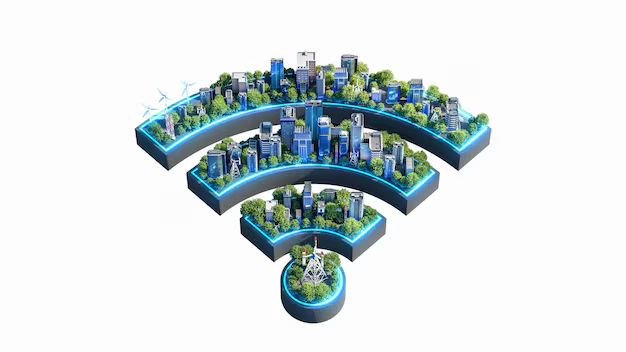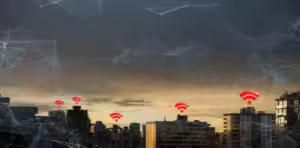Public transport is an essential part of urban mobility, connecting millions of commuters to their workplaces, homes, and recreational destinations daily. In today’s digital age, seamless connectivity has become a necessity rather than a luxury, with passengers expecting uninterrupted access to the internet while traveling. Whether for work, entertainment, or navigation, wireless networking in public transport enhances commuter experiences by providing real-time information, improved safety, and greater convenience.
Advancements in wireless technologies, including Wi-Fi, 4G, 5G, and satellite-based communications, have transformed the way people engage with public transportation systems. Many cities worldwide are investing in smart transport solutions that integrate high-speed internet access, enabling passengers to stay connected throughout their journey. However, despite these advancements, challenges such as network congestion, infrastructure costs, and security concerns continue to impact the widespread adoption of wireless networking in public transport.
This article explores the evolution of wireless networking in public transport, key technologies enabling connectivity, benefits for commuters and transport operators, challenges in implementation, and trends shaping the future of commuter connectivity.

Evolution of Wireless Networking in Public Transport
The journey of wireless networking in public transport has evolved significantly over the years, transforming from basic infrastructure to advanced, high-speed connectivity solutions. As passenger demands for seamless internet access have grown, public transportation systems worldwide have adopted innovative technologies to enhance commuter experiences.

Early Challenges and Limitations
In the early 2000s, internet access on public transport was limited due to technological constraints and high implementation costs. The primary challenges included:
- Limited Network Infrastructure: Most transport systems lacked the necessary hardware to support wireless internet access.
- High Deployment Costs: Installing Wi-Fi and mobile connectivity solutions requires significant investment.
- Slow and Unstable Connections: Early mobile networks, such as 2G and 3G, offered slow speeds and unreliable connectivity, especially in moving vehicles.
- Security Concerns: Lack of encryption and authentication mechanisms led to privacy risks for users.
Technological Advancements and Adoption
With the advancement of wireless communication technologies, public transport systems began integrating improved connectivity solutions:
- Wi-Fi Deployment (Mid-2000s to Early 2010s): Many cities started offering onboard Wi-Fi in buses, trains, and metros to attract commuters and improve travel experiences.
- 4G LTE Implementation (2010s): The introduction of 4G networks enabled higher-speed internet access, making video streaming, online work, and social media browsing more efficient for commuters.
- Mobile App Integration: Transport operators began integrating internet-based services such as mobile ticketing, live tracking, and digital payments into their systems.
The Era of High-Speed Connectivity (Present and Beyond)
As the demand for faster and more reliable connectivity continues to grow, the public transport sector is embracing cutting-edge technologies:
- 5G Deployment: The rollout of 5G networks is set to revolutionize public transport by providing ultra-fast, low-latency internet access.
- Satellite-Based Internet: Services like Starlink and OneWeb are expanding connectivity to remote and underground transport routes.
- Edge Computing & IoT Integration: Smart transportation systems leverage edge computing and IoT devices to optimize network performance and provide real-time data analytics.
The evolution of wireless networking in public transport has significantly enhanced commuter experiences, paving the way for smarter, more connected transit systems. As new innovations emerge, the future of public transport will continue to prioritize seamless, high-speed, and secure connectivity for all passengers.

Benefits of Wireless Networking in Public Transport
The integration of wireless networking in public transport has transformed the commuter experience, making travel more convenient, efficient, and enjoyable. High-speed connectivity in buses, trains, and metro systems offers numerous advantages for both passengers and transport operators.
1. Enhanced Passenger Experience
- Uninterrupted Connectivity: Commuters can browse the internet, work remotely, stream content, and stay connected with friends and family while traveling.
- Improved Productivity: Business travelers and students can utilize their commute time for emails, online meetings, and study sessions.
- Entertainment on the Go: Access to Wi-Fi enables passengers to stream music, watch videos, and use social media without relying on mobile data.
2. Real-Time Information Access
- Live Tracking and Navigation: Passengers can check real-time location updates, estimated arrival times, and route changes via transport apps.
- Seamless Digital Ticketing: Wireless networks support contactless payments, mobile ticketing, and QR-based entry, reducing wait times and paper waste
- Weather and Traffic Updates: Commuters receive real-time alerts on delays, diversions, and weather conditions, helping them plan their journeys efficiently.
3. Enhanced Safety and Security
- Surveillance and Monitoring: Wireless networks support real-time CCTV monitoring, ensuring passenger safety by deterring crime and vandalism.
- Emergency Communication: Transport authorities can send instant alerts and notifications in case of breakdowns, accidents, or security threats.
- Remote Assistance: Passengers can access emergency services and customer support via connected help kiosks or mobile apps.
4. Operational Efficiency for Transport Providers
- Fleet Management: Wireless connectivity enables GPS tracking, remote diagnostics, and predictive maintenance, reducing downtime and improving service reliability.
- Data-Driven Insights: Transport operators can analyze passenger usage patterns, optimize routes, and manage peak-hour traffic efficiently.
- Energy and Cost Savings: Smart systems help reduce fuel consumption, manage power usage, and lower operational costs through automation and real-time monitoring.
Wireless networking in public transport is no longer just an added convenience—it is a necessity for modern, smart cities. By improving connectivity, accessibility, and efficiency, it plays a crucial role in enhancing commuter satisfaction and optimizing urban mobility.

Conclusion
The integration of wireless networking in public transport has revolutionized the way commuters experience daily travel. With seamless internet access, passengers can stay connected, informed, and entertained throughout their journeys. Whether through Wi-Fi hotspots, 4G/5G networks, or satellite-based solutions, reliable connectivity enhances commuter convenience, safety, and productivity.
Despite the challenges of infrastructure costs, network congestion, and security concerns, ongoing advancements in technology are driving smarter, more efficient public transport systems. The adoption of 5G, IoT, and AI-powered network optimizations will further enhance real-time data processing, fleet management, and passenger engagement.
As cities continue to evolve into smart, connected ecosystems, investing in robust wireless networking infrastructure will be key to ensuring a seamless, high-speed, and secure transport experience. The future of public transportation lies in intelligent connectivity, making travel more efficient, sustainable, and commuter-friendly.












